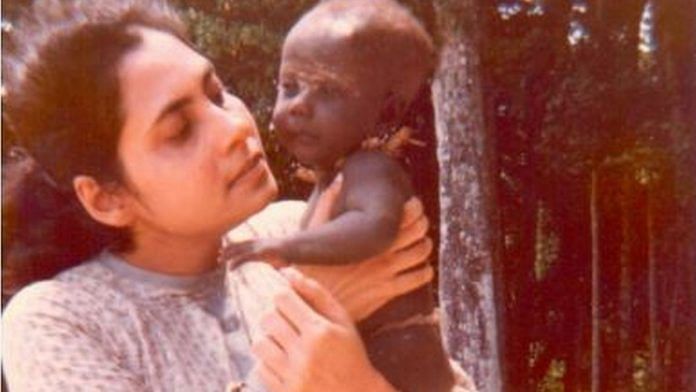Anthropologist Madhumala Chattopadhyay talks about ‘missionary’ John Allen Chau’s fatal visit to the Sentinelese island.
The Sentinelese are strong — one middle-aged Sentinelese man can take down five young men — and have rebuffed outsiders for centuries. John Allen Chau, the ‘missionary’, went to the North Sentinelese Island illegally and was allegedly killed. He unethically bribed fishermen to take him to the North Sentinel Island. And he wasn’t the first Christian missionary to do so.
Many foreigners have tried to approach the Sentinelese — some even from nearby Myanmar and Indonesia. And the local fishermen are always ready to take them to these no-contact islands in exchange for money. But these trips have either ended fatally or with no success.
I visited the Sentinelese tribe in the Andamans years ago as a researcher with the Anthropological Survey of India. Official tours to the Sentinel islands have been closed for years now because of their small population and their hostility towards outsiders.
Also read: Madhumala Chattopadhyay, the woman who made the Sentinelese put their arrows down
When we first reached out, we exchanged fruits like raw bananas (which the Jarawas love roasting) and coconuts (which the Sentinelese used) for hours at an end to gain their trust. It’s an exercise in patience.
The Sentinelese see no difference between a journalist, researcher, police or missionaries approaching them. In fact, when police personnel went with our contact-teams to these islands, they would have to be dressed in plain clothes. The retrieval of John Allen Chau’s body is up to the police, Indian and US administrations. I don’t know whether the Sentinelese will even allow them to come to the island — they are angry. But it’s not like they attack first-off, they show warning signs — through facial gestures, knives, bows and arrows — and then take action if those are disrespected. John Allen Chau must have faced a similar situation.
Most of the tribes in the Andamans, including the Sentinelese, are animists. They worship nature. I saw their practices when I lived with them, months at an end. Those who pray to the sky, water, and land — what’s Christianity or Hinduism to them? When I visited the Great Nicobar Islands, I saw that most of them had been forcefully converted to Christianity. But they do not adhere to that religion— when the time for prayer comes, some sit on chairs and protest. Unlike Christians, they make wooden replicas of those who die and leave out food and water for them.
When the British ruled India, they tried to contact the 10 tribes in the Andamans, whose population was over 3,000 at the time. Angered at British attempts to set up a penal colony, the tribes attacked the British in 1859. The battle of Aberdeen or Andaman was fought between two groups— one with bows and arrows, another with guns. Many tribes were wiped out. The remaining tribal people were segregated into ‘Andaman Homes’ where diseases like measles claimed lives. Later, syphilis and other venereal diseases started spreading after the British exploited tribal women, killing off more chunks of the population.
Also read: John Allen Chau ‘lost his mind’, was aware of dangers of North Sentinel Island, say friends
Considering their dwindling population and vulnerability, it was decided that the Indian government would not interfere in their lives. These tribes will anyway die out because of their small numbers as well as their limited gene pool. But if we interfere, they will die out sooner. Many rules and regulations are now in place to keep these tribes isolated.
If you are Indian by birth, you may still get permissions to study the tribal people, but if your child is born abroad, he/she will not be given access. Similarly, if you work in the Anthropological Survey of India, you will be allowed to work only in the region you have been posted to, even if you want to go to the Andamans to study.
Except for natural calamities, we should not contact them. And if we do contact, as we did after the tsunami in 2004. It should be through the government only – that way they will start accepting and trusting a small group to help them in times of crisis.
Also read: Sentinelese are peace loving, leave them alone, says anthropologist who has met them
The Sentinelese and other tribes don’t need to be oppressed with religion, because doing so will make them more hostile. They understand nature, and that’s all they need. For instance, when I was with the Jarawas, I was travelling one day from one village to another, but they asked me not to go since it was going to rain. This was a bright sunny day! But it did rain within half an hour, such is their understanding of nature.
If I got the opportunity to visit the Andamans again now, I would. I last visited in 1999, after Union minister Maneka Gandhi urged me to go. The Jarawas there recognised me and called out, “milale milale”, their term for ‘friend’. They always remember.
As told to Neera Majumdar.
Madhumala Chattopadhyay was a researcher with Anthropological Survey of India and currently works at the ministry of social justice and empowerment. Views expressed are personal.







There seems to be some misconception about sentanalese.They do not seem to be isolated.If keenly absorbed their photos published suggests they seem to be wearing some kind of dress,head scorf or some cover-ups unless the photos are photoshopped.if they are isolated where do they get the dress from?
That is a beautiful photograph, has a Madonna like quality to it.
Did she visit sentenelese.many people have made friends with jarawas,she is confusing us.she could tell something about sentenalese if she visited them.
The article does not mention anything about their life styles their customs, rituals etc?
Yes, they don’t want to. Because it’s about Christianity spreading. But This tribe are authentic in their own way. Unnecessary apply nonsense on them.